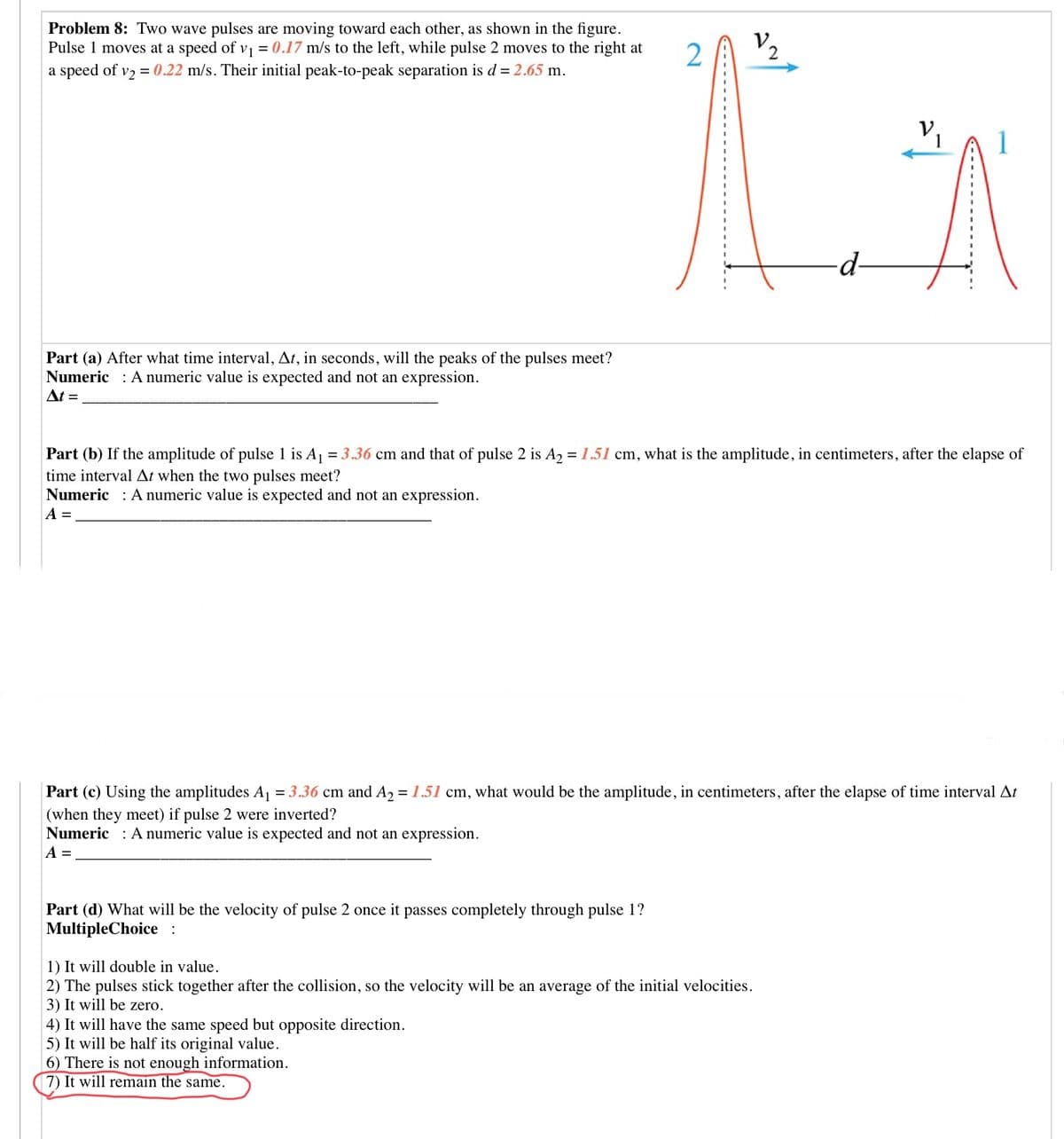Problem 8: Two wave pulses are moving toward each other, as shown in the figure. Pulse 1 moves at a speed of v = 0.17 m/s to the left, while pulse 2 moves to the right at a speed of v2 = 0.22 m/s. Their initial peak-to-peak separation is d = 2.65 m. V. 2 -d- Part (a) After what time interval, At, in seconds, will the peaks of the pulses meet? Numeric : A numeric value is expected and not an expression. At = Part (b) If the amplitude of pulse 1 is A, = 3.36 cm and that of pulse 2 is A2 = 1.51 cm, what is the amplitude, in centimeters, after the elapse of time interval At when the two pulses meet? Numeric : A numeric value is expected and not an expression. A = Part (c) Using the amplitudes A1 = 3.36 cm and A2 = 1.51 cm, what would be the amplitude, in centimeters, after the elapse of time interval At (when they meet) if pulse 2 were inverted? Numeric A numeric value is expected and not an expression. A =
Problem 8: Two wave pulses are moving toward each other, as shown in the figure. Pulse 1 moves at a speed of v = 0.17 m/s to the left, while pulse 2 moves to the right at a speed of v2 = 0.22 m/s. Their initial peak-to-peak separation is d = 2.65 m. V. 2 -d- Part (a) After what time interval, At, in seconds, will the peaks of the pulses meet? Numeric : A numeric value is expected and not an expression. At = Part (b) If the amplitude of pulse 1 is A, = 3.36 cm and that of pulse 2 is A2 = 1.51 cm, what is the amplitude, in centimeters, after the elapse of time interval At when the two pulses meet? Numeric : A numeric value is expected and not an expression. A = Part (c) Using the amplitudes A1 = 3.36 cm and A2 = 1.51 cm, what would be the amplitude, in centimeters, after the elapse of time interval At (when they meet) if pulse 2 were inverted? Numeric A numeric value is expected and not an expression. A =
Physics for Scientists and Engineers
10th Edition
ISBN:9781337553278
Author:Raymond A. Serway, John W. Jewett
Publisher:Raymond A. Serway, John W. Jewett
Chapter17: Superposition And Standing Waves
Section: Chapter Questions
Problem 50CP
Related questions
Question
10.8 a-c

Transcribed Image Text:Problem 8: Two wave pulses are moving toward each other, as shown in the figure.
Pulse 1 moves at a speed of v = 0.17 m/s to the left, while pulse 2 moves to the right at
2
a speed of v2 = 0.22 m/s. Their initial peak-to-peak separation is d = 2.65 m.
1
1
-d-
Part (a) After what time interval, At, in seconds, will the peaks of the pulses meet?
Numeric : A numeric value is expected and not an expression.
At =
Part (b) If the amplitude of pulse 1 is A1 = 3.36 cm and that of pulse 2 is A2 = 1.51 cm, what is the amplitude, in centimeters, after the elapse of
time interval At when the two pulses meet?
Numeric : A numeric value is expected and not an expression.
A =
Part (c) Using the amplitudes A, = 3.36 cm and A2 = 1.51 cm, what would be the amplitude, in centimeters, after the elapse of time interval At
(when they meet) if pulse 2 were inverted?
Numeric : A numeric value is expected and not an expression.
A =
Part (d) What will be the velocity of pulse 2 once it passes completely through pulse 1?
MultipleChoice :
1) It will double in value.
2) The pulses stick together after the collision, so the velocity will be an average of the initial velocities.
3) It will be zero.
4) It will have the same speed but opposite direction.
5) It will be half its original value.
6) There is not enough information.
7) It will remain the same.
Expert Solution
This question has been solved!
Explore an expertly crafted, step-by-step solution for a thorough understanding of key concepts.
This is a popular solution!
Trending now
This is a popular solution!
Step by step
Solved in 3 steps

Knowledge Booster
Learn more about
Need a deep-dive on the concept behind this application? Look no further. Learn more about this topic, physics and related others by exploring similar questions and additional content below.Recommended textbooks for you

Physics for Scientists and Engineers
Physics
ISBN:
9781337553278
Author:
Raymond A. Serway, John W. Jewett
Publisher:
Cengage Learning

Physics for Scientists and Engineers with Modern …
Physics
ISBN:
9781337553292
Author:
Raymond A. Serway, John W. Jewett
Publisher:
Cengage Learning

Physics for Scientists and Engineers, Technology …
Physics
ISBN:
9781305116399
Author:
Raymond A. Serway, John W. Jewett
Publisher:
Cengage Learning

Physics for Scientists and Engineers
Physics
ISBN:
9781337553278
Author:
Raymond A. Serway, John W. Jewett
Publisher:
Cengage Learning

Physics for Scientists and Engineers with Modern …
Physics
ISBN:
9781337553292
Author:
Raymond A. Serway, John W. Jewett
Publisher:
Cengage Learning

Physics for Scientists and Engineers, Technology …
Physics
ISBN:
9781305116399
Author:
Raymond A. Serway, John W. Jewett
Publisher:
Cengage Learning

Principles of Physics: A Calculus-Based Text
Physics
ISBN:
9781133104261
Author:
Raymond A. Serway, John W. Jewett
Publisher:
Cengage Learning

Physics for Scientists and Engineers: Foundations…
Physics
ISBN:
9781133939146
Author:
Katz, Debora M.
Publisher:
Cengage Learning

University Physics Volume 1
Physics
ISBN:
9781938168277
Author:
William Moebs, Samuel J. Ling, Jeff Sanny
Publisher:
OpenStax - Rice University